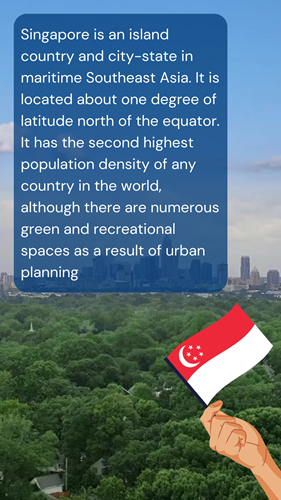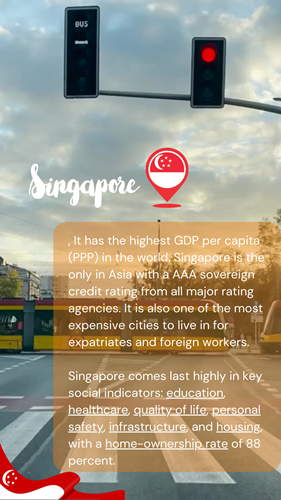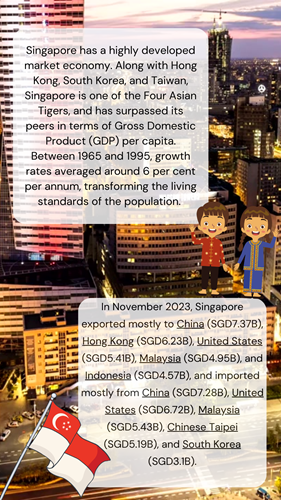Analysis and Studies - Country Analysis
Singapore: a look at the market
February 5th 2024
Singapore is an island country and city-state in maritime Southeast Asia. It is located about one degree of latitude north of the equator.
It has the second highest population density of any country in the world, although there are numerous green and recreational spaces as a result of urban planning. Moreover, It has a multicultural population and in recognition of the cultural identities of the major ethnic groups within the nation, Singapore has four official languages: English, Malay, Mandarin and Tamil. English is the lingua franca, with its exclusive use in numerous public services. After many years of turbulence, with its growth based on international trade and economic globalization, It integrated itself with the world economy through free trade with minimal to no trade barriers or tariffs, export-oriented industrialization, and the large accumulation of received foreign direct investments, foreign exchange reserves and assets held by sovereign wealth funds.

Furthermore, It has the highest GDP per capita (PPP) in the world. Singapore is the only in Asia with a AAA sovereign credit rating from all major rating agencies. It is also one of the most expensive cities to live in for expatriates and foreign workers.

Singapore comes last highly in key social indicators: education, healthcare, quality of life, personal safety, infrastructure, and housing, with a home-ownership rate of 88 percent. Singaporeans enjoy one of the longest life expectancies, fastest Internet connection speeds, lowest infant mortality rates, and lowest levels of corruption in the world.
About Economy

Singapore has a highly developed market economy. Along with Hong Kong, South Korea, and Taiwan, Singapore is one of the Four Asian Tigers, and has surpassed its peers in terms of Gross Domestic Product (GDP) per capita. Between 1965 and 1995, growth rates averaged around 6 per cent per annum, transforming the living standards of the population.
The currency of Singapore is the Singapore dollar (SGD or S$), issued by the Monetary Authority of Singapore (MAS). MAS manages its monetary policy by allowing the Singapore dollar exchange rate to rise or fall within an undisclosed trading band. Singapore has the world's eleventh largest foreign reserves, and one of the highest net international investment position per capita.
In November 2023 Singapore exported SGD 43.9 billion and imported SGD 38.2 billion, resulting in a positive trade balance of SGD 5.67 billion. Between November 2022 and November 2023 the exports of Singapore have increased by SGD 1.1 billion (2.58%) from SGD 42.8B to SGD 43.9B, while imports decreased by SGD-1.87B (-4.68%) from SGD 40.1B to SGD 38.2B.
TRADE
In November 2023, the top exports of Singapore were Electrical Machinery Apparatus & Appliances Nes... (SGD15.4B), Petroleum & Products & Related Materials (SGD7.45B), Oil Bunkers (SGD3.27B), Telecommunications & Sound-Recording & Reproducing Apparatus... (SGD2.52B), and Office Machines & Automatic Data-Processing Machines (SGD2.14B).
In November 2023 the top imports of Singapore were Electrical Machinery Apparatus & Appliances Nes... (SGD12.2B), Petroleum & Products & Related Materials (SGD10.8B), Telecommunications & Sound-Recording & Reproducing Apparatus... (SGD2.21B), Office Machines & Automatic Data-Processing Machines (SGD1.8B), and Miscellaneous Manufactured Articles Nes (SGD1.58B).
DESTINATIONS
In November 2023, Singapore exported mostly to China (SGD7.37B), Hong Kong (SGD6.23B), United States (SGD5.41B), Malaysia (SGD4.95B), and Indonesia (SGD4.57B), and imported mostly from China (SGD7.28B), United States (SGD6.72B), Malaysia (SGD5.43B), Chinese Taipei (SGD5.19B), and South Korea (SGD3.1B).
GROWTH
In November 2023, the increase in Singapore's year-by-year exports was explained primarily by an increase in exports to Hong Kong (SGD928M or 17.5%), United States (SGD619M or 12.9%), and Thailand (SGD610M or 34.6%), and product exports increase in Electrical Machinery Apparatus & Appliances Nes... (SGD607M or 4.11%), Medicinal & Pharmaceutical Products (SGD520M or 44.2%), and Organic Chemicals (SGD378M or 23.9%). In November 2023, the decrease in Singapore's year-by-year imports was explained primarily by an decrease in imports from Malaysia (SGD-1.35B or -19.9%), China (SGD-1B or -12.1%), and Brazil (SGD-656M or -57.9%).
Fonti:
https://oec.world/en
https://data.worldbank.org/
https://www.trademap.org/
